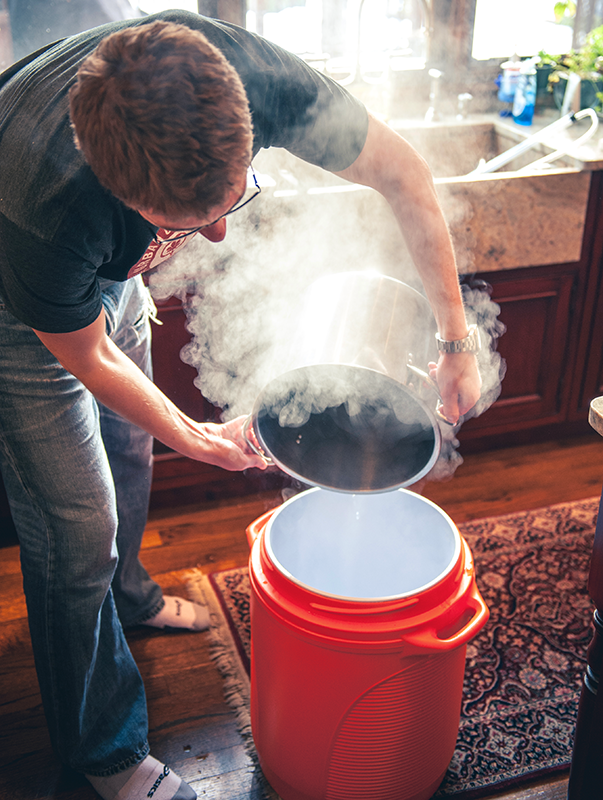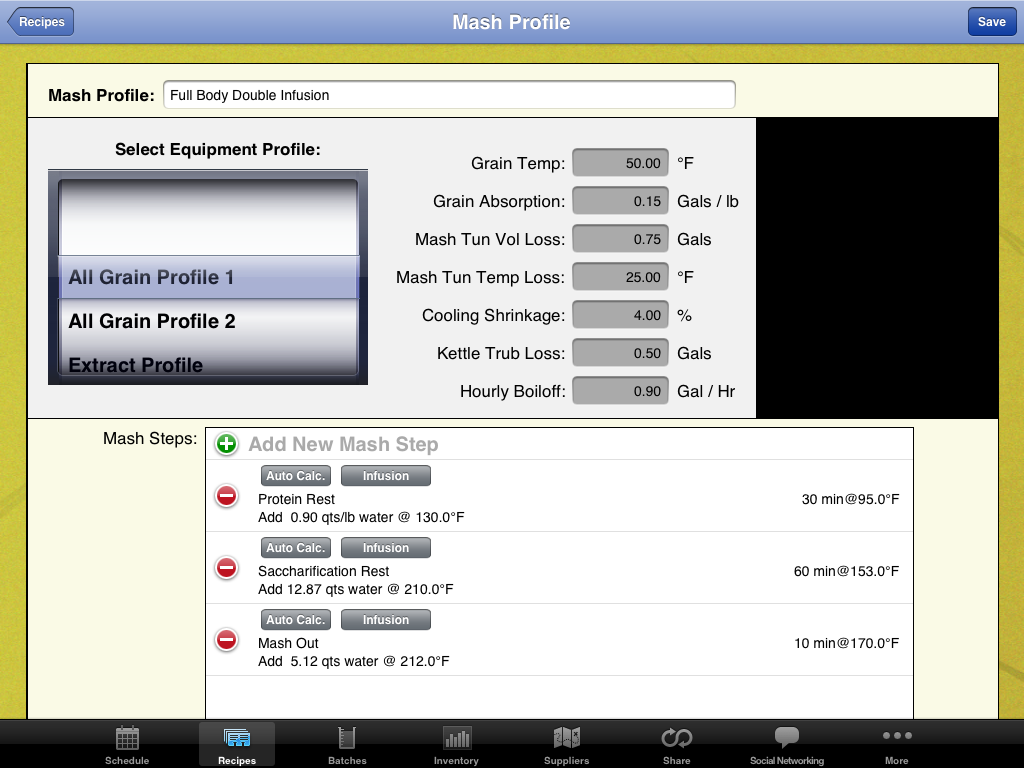 We recently had a question on the E. C. Kraus Homebrewing Blog about doing a double infusion mash in a mash tun cooler. Since I recently used this procedure for my black lager, I figured I’d walk you through the step-by-step of a double infusion mash.
We recently had a question on the E. C. Kraus Homebrewing Blog about doing a double infusion mash in a mash tun cooler. Since I recently used this procedure for my black lager, I figured I’d walk you through the step-by-step of a double infusion mash.
The challenge when doing a double infusion mash in a cooler-style mash tun is that you can’t add heat directly to the mash tun. To raise the temperature of the mash, you have to add enough water of a certain temperature to raise the temperature of the mash to hit your target mash temperature. The math is a little complicated, so I prefer to use a software program to help me figure out the water additions. In this case, I’m using iBrewMaster.
The mash schedule as specified by my beer recipe calls for the following:
- 30 minutes at 95˚F (protein rest)
- 60 minutes at 153˚F (saccharification rest)
- 10 minutes at 170˚F (mash out)
The trick with using a software program is that it takes a few batches to calibrate the constant figures in the program. There are a number of factors that influence the calculations, including:
- Grain weight
- Grain temperature
- Mash tun temperature
- Mash tun volume loss
The mash tun volume loss should be a constant, but grain temperature and mash tun temperature may change with the season if you keep all of your brewing gear in a garage or basement. Ideally, you’ve already brewed a few times and you have a good idea of these numbers. I’ve filled them in to the iBrewMaster defaults under “Equipment Profiles.”

After entering these numbers, I can apply the equipment profile and mash profile to the recipe to calculate how much water I need for each step of the double infusion mash. Here’s what it gave me:
- 5 qts. of water at 129˚F to hit 95˚F
- 57 qts. of water at 212˚F to hit 153˚F
- 59 qts. of water at 212˚F to hit 170˚F
- 8 qts. of water for sparging
Now it takes a little common sense to look at these numbers. 28.8 qts. is more than enough sparge water for a five-gallon batch. In reality, it will only be 2-3 gallons, but it’s better to have too much than too little!
 From here on out, brew day is pretty simple. Follow the mash schedule for the double-infusion mash, simply mixing in the water into the cooler at the appropriate time. The only exception is the sparge water. To avoid diluting the wort, I recommend mixing in the sparge water gradually. Either do a fly sparge, in which the water trickles in over the grains at the same rate that it leaves the mash tun, or a batch sparge, where the mash tun is completely drained, then you calculate how much additional wort you need, then mix in that amount of sparge water into the mash tun and drain again. Read this post about homebrew sparging techniques to learn more about batch vs. fly sparging.
From here on out, brew day is pretty simple. Follow the mash schedule for the double-infusion mash, simply mixing in the water into the cooler at the appropriate time. The only exception is the sparge water. To avoid diluting the wort, I recommend mixing in the sparge water gradually. Either do a fly sparge, in which the water trickles in over the grains at the same rate that it leaves the mash tun, or a batch sparge, where the mash tun is completely drained, then you calculate how much additional wort you need, then mix in that amount of sparge water into the mash tun and drain again. Read this post about homebrew sparging techniques to learn more about batch vs. fly sparging.
The beer recipe for this black lager is fairly simple, so I won’t walk through the remaining step of the brew day: boil, chill, pitch yeast!
Check back soon to see how this black lager turns out!
———————————–
David Ackley is a beer writer, homebrewer, and self-described “craft beer crusader.” He holds a General Certificate in Brewing from the Institute of Brewing and Distilling and is founder of the Local Beer Blog.
